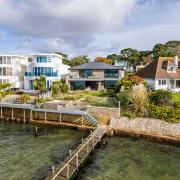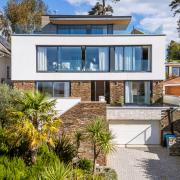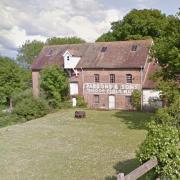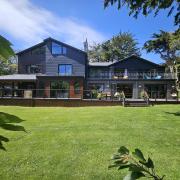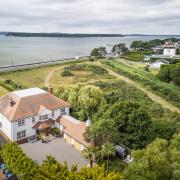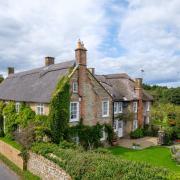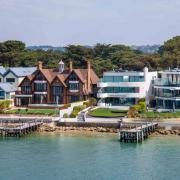‘I love the long-term vision of people who plant things knowing they won’t see them come to maturity,’ says Monique Gudgeon, pointing to a 3.5m cedar of Lebanon, one of over a thousand trees and shrubs growing here. ‘I won’t see this become a massive tree, but I hope that in 200 years someone will admire it and wonder who planted it. You must be an optimist when planting trees!’ she laughs.
I’ve joined the Garden Director of Sculpture by the Lakes, near Dorchester, for an informative walk around the 26-acre site to not only admire a dazzling array of sculptures, part of the FORM exhibition (until June 1), but also to view their collection of endangered conifers. These modest trees are one of the reasons that this venue was awarded Botanic Garden Status last summer, one of only 10 in the country, and a first for Dorset.

The springboard for Monique’s leap into the world of gardening was her desire to leave London and step away from a career in PR. This new career started in the mid-1990s with a National Certificate in Horticulture from Brinsbury College in West Sussex. This was followed by a job at Agriframes near Bristol who make garden arches, pergolas, obelisks and fruit cages. ‘I looked after their show garden. We also grew all the plants for their trade stands at RHS Chelsea and Hampton Court.’
From there Monique landed a job with Architectural Plants in West Sussex, headed up by Angus White. ‘They were the first nursery in the UK to import hardy exotics,’ she tells me. ‘Tree ferns, hardy palms, hardy bananas and a lot of Mediterranean plants such as mature olive trees, all in great demand for RHS Chelsea. We also had Japanese Niwaki cloud trees, essentially garden-sized bonsai that go in the ground.’
What this firmly established for Monique is that trees and woody shrubs were her thing. ‘I just don’t get herbaceous borders, they are so fickle,’ she admits. ‘Though I do have a very small herbaceous border by the house, and a rose garden full of scented roses. But anything that requires too much TLC I can’t be dealing with.’

Creating a Sculpture Park
While working for Architectual Plants, Monique married Simon Gudgeon. He too had started a new career, ditching law for painting. ‘Simon did various jobs including housesitting. He would paint a portrait of their dog or cat and when the owner returned, they invariably bought it!’ Simon branched out into sculpture, and then into monumental works which were far too big for his studio, a former piggery in the grounds of a cottage the couple rented near the New Forest.
Monique searched the internet for properties in the West Country with an acre of land and an outbuilding. ‘Up popped Pallington Lakes,’ she waves her arm over the lake in front of us, as a grey-legged goose ushers its goslings onto the water. ‘Double our budget, 26-acres, with outbuildings and a fishery.’ A friend of Simon’s who specialised in fisheries told him that not only was this one of the most beautiful fishing lakes in the country, but it also had an income from a fishing syndicate. ‘So, we crunched the numbers and realised we could just about afford it.’ They moved here in January 2007.
The River Frome runs through the site which includes three lakes, some small ponds and a stream. Once Simon’s new studio was built, he was spurred on to create. ‘Sculptors and artists are rather like goldfish; they grow according to the size of their tank,’ smiles Monique. ‘So, given this huge canvas, Simon was able to expand what he was doing.’ Simon’s works are several metres high and the landscape gives a great setting for their scale.. ‘We wanted to create somewhere where people could look at sculpture and hoped they would buy a piece.’

Monique used her plantswoman’s skills to create the planting around the pieces and how each is framed. ‘Sometimes a sculpture dictates what it wants, other times the landscape suggests itself. If I see a great place for a sculpture, I show Simon who will often create a piece for that setting. When it’s in situ, if the dynamic isn’t quite right, then we move it to another location.’
With various pieces placed around the grounds, the couple faced a dilemma. Could the site be viable just as a sculpture park, or should it remain a fishery? They knew the two wouldn’t mix.
They opened the sculpture park to the public on June 4, 2011 for two weeks to raise money for the charity Help for Heroes. ‘The first morning we got 300 people – we were thrilled,’ says Monique. ‘And the numbers just kept growing.’ Two days later they had a runaway success on their hands. And so, the private fishery was closed.
Since then, Sculpture by the Lakes has expanded to include a cafe, shops, a gallery and some of the swankiest loos I’ve ever seen. They’ve won numerous accolades as a visitor attraction, and the venue has hosted a wide range of events from wellbeing festivals to art exhibitions and plant fairs.

Making a Botanic Garden
A visit to a garden in Jersey in 2019 that would see Monique embark on an exciting new venture for the sculpture park. ‘We had some time to kill before going to an art exhibition and The Botanic Gardens at Samarès Manor was nearby,’ Monique recalls. ‘Then Simon asked what makes it a botanical garden. I didn’t know but decided to find out.’
She discovered is that a botanic garden should embody four things: education, conservation, science/research and enjoyment. ‘We already ticked education, conservation and enjoyment at Sculpture by the Lakes.’ She then found out about the Botanic Gardens Conservation International (BGCI), based at Kew Gardens, who will accredit a garden with botanic status if it meets their strict criteria.
Over the next three years Monique worked hard to ensure the gardens gained this prestigious accolade. Plants had to be labelled, interpretation boards about specific plants erected, and gardening workshop events offered. But how to tick that science and research box?

A Rare Conifer Collection
‘The garden needed some evergreens. My sister who is a real tree buff suggested the Korean fir, a very pretty tree with lovely cones. I then discovered that they are endangered in the wild.’ Monique then came across the International Conifer Conservation Programme at Royal Botanic Garden Edinburgh. ‘Their website lists every single conifer that is threatened around the world. To my surprise ,we had quite a few growing here. That sparked an idea that part of our botanic garden status could include growing a small collection of threatened conifers.’
At the time, Monique was volunteering at Kew Gardens. They donated a small collection of rare conifers, and then Royal Botanic Garden Edinburgh, looking to find homes for 600 endangered conifers, added 17 more trees, forming the collection's nucleus. ‘There are still more I would love to get, but it’s a question of space. They get so big.’
She gives the example of the grove of sequoia or coast redwood they have, which can live for between 1,200–2,200 years or more. ‘Sequoia is endangered in the wild. However, they love our climate and are doing better here than in America. In a thousand years' time the biggest and oldest sequoia could be in the UK. Preserving that genetic material here in Dorset is important. Due to climate change, Northern Europe will be the ex-situ site for some of these endangered conifers. We will have the propagation material to help species survive.’

Fabulous Forsythia
Sculpture by the Lakes also holds the National Collection of Forsythia. ‘Plant Heritage, which administers the National Collections, has a list of species genera that are still unclaimed,’ Monique explains. ‘I was amazed to see such as well-known plant on the list and immediately wanted to give it a home.’
The collection was planted during lockdown and is now thriving. ‘There are 80 different cultivars of forsythia – all yellow – but with different habits.’ Interpretation boards explain the different cultivars. Even in early May I could spy the occasional acid yellow flower. ‘I have 64 different cultivars here, so there are another 16 or 17 that have already disappeared. I have feelers out for these lost plants. This happens a lot, plants simply get forgotten in a garden and then become extinct.’
The forsythia collection sits on a dry, impacted rocky causeway between two lakes. ‘They grow on mountainsides in China, Korea and Japan, and they like lots of light. They loved the wet winter; the blooms were spectacular this year.’ She also takes lots of cuttings to ensure the survival of the collection, too many to keep though. She offers me one of her favourite forsythias to plant in my garden. I’m thrilled as I adore forsythia.
Monique’s burgeoning interest in rhododendrons, camellias and azaleas is bringing even more spring colour into the gardens, as are flowering cherries. There are also plans for a winter border featuring colourful dogwoods and willows with sweet-scented flowering shrubs like Chimonanthus (wintergreen).
‘My botanic garden journey has introduced me to such an amazing array of gardeners around the world,’ says Monique, her eyes shining. ‘That’s what I love about social media, I have access to the most amazing network via Facebook and Instagram. The botanic garden status opened lots of doors and gave me credibility with my peers. Though I still think of myself as an enthusiastic amateur compared to professional gardeners who trained at Kew, nurturing this garden is my job and I love it.’





